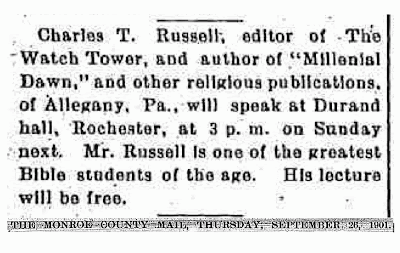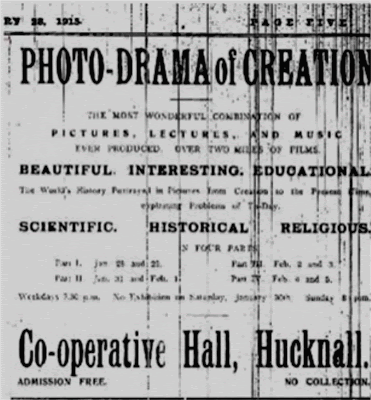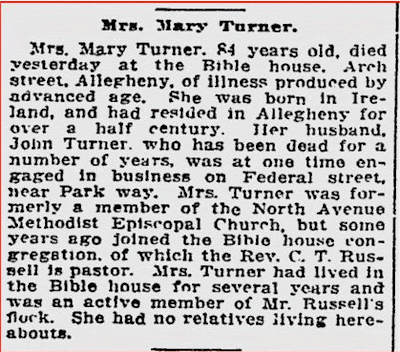by “Jerome”
Obituaries are a good source of
information, although when it comes to accuracy they can leave a lot to be
desired. The events involving the subject are often a long time in the past,
and memory can let people down or cause them to even embroider the story; much
as funeral orations tends to (in the words of a popular song) “accentuate the
positive, and eliminate the negative...”
So we have the obituary of Joseph L
Russell, which states he came to America “about 1845.” The word of hesitation –
“about” – has since been turned into a more definite statement in some
writings, and also in the commentary of a history DVD. However, Joseph’s
naturalisation papers, completed in 1848 show that he needed to have been in
the United States for at least five years prior to signing the document.Then there is also some detail in the obituary of Hugh Brown Rice, the main subject of this article.
Rice died in 1905, and his
obituary in the Los Angeles Herald for November 3, 1905, highlighted that he
was a religious man, but concentrated on his business success as a travel agent
for Steamship Lines. His pallbearers were all business associates, not
religious associates. There is no mention of his passing in the Restitution, a
paper that once carried letter after letter from him. Anyone can check the full
obituary on the Find a Grave site.
But there was another obituary
published in the Obituary Record of Graduates of Amherst College, for the
Academical Year Ending June 27, 1906, Amherst, Massachusetts, 1906, page 158.
This adds some more detail, and
it is here that the memory of surviving relatives lets the side down. It
states: “During
the last twenty-five years of his life he regularly taught a large and
enthusiastic Bible class in Los Angeles. He was a frequent contributor to
religious publications, and for several years published a small monthly paper
called The Last Trump.”
Let’s
do the math here. He regularly taught a large and enthusiastic Bible class in
Los Angeles for twenty-five years? That would take us back to around 1880, the
time he had a brief association with CTR and Nelson Barbour. Was his Bible
class large and enthusiastic and continuous? In the latter part of the 1880s
many letters from Rice were published in the Restitution newspaper. They showed
Rice struggling to makes ends meet as an unsuccessful farmer, and storekeeper,
and bemoaning his isolation from those of like faith. They repeatedly ask for
financial help so he can go preaching. On one documented occasion he leaves his
family in near penury, goes preaching far away and runs out of money and has
great difficulty getting home. For more details of Rice’s continuing tales of woe,
see an earlier article on this blog from July 1, 2012, H B RICE - AN IMPECUNIOUS MAN. There is also a typical letter from the
period reproduced at the end of this article, which stresses both his isolation
and lack of funds.
The Amherst obituary also mentions his
paper The Last Trump running for several years. This would appear to be a “folk
memory” on the part of his family. It ran for about three issues and then
folded prior to the start of Zion’s Watch Tower. When a dramatic reversal
occurred in Rice’s fortunes at the very end of the 80s, he disappears
completely from the pages of extant One Faith/Age to Come publications. For Rice to have published for several years
would have meant his re-starting it when he finally got on his feet financially
in the 1890s. While the old adage holds true that absence of evidence is not
necessarily evidence of absence, it would seem extremely doubtful.
Once Rice finally gets his finances in
order, his dreams of an active ministry disappear into the relief of actually
making a reasonable living for a growing family. The Los Angeles Herald obituary
mentions a N W J Straub, whose Bible class he attended, but Straub is not to be
found in the Restitution.
Perhaps the main thing the Amherst
obituary does for us is draw two diverse pictures together. On one hand we have
the financial failure – the struggling letter writer regularly pleading year
after year for financial help – and on the other we have the prosperous
businessman with his own travel agency. The two are so disparate, you could be
forgiven for wondering if these were two different men – both coincidentally
named Hugh B Rice. At least the Amherst obituary shows this was the same man –
even if the details have been blurred and distorted in the telling.
Basically, Rice’s obituary highlights
the major flaw in all obituaries – the one person who could verify the
information is unfortunately not there to do so.
Below is a typical letter from H B Rice,
as published in The Restitution for November 7, 1888, page 4.
DELANO, Cal.
Dear Restitution:
Although far away from any church
organization and having none of that “fellowship of kindred minds” which
Christians so much need and which I so much covet, I must write to express my
deep interest in the movement now being towards organization of our forces.
Co-operation is certainly Scriptural and wise and needful in our work. How I
would rejoice could I be present in Philadelphia at the General Conference. May
God direct you all in your planning and may the much needed union of effort be
well begun and enthusiastically carried out.
Since it has pleased God by the “foolishness
of preaching” (not foolish preaching), to save those who believe, we canst
preach if we save any. Now I am too much burdened by the cares of a large and
helpless family, and poverty, brought on by sundry mistakes in business
enterprise and consequent indebtedness, to hope to be able to give my whole
time to this glorious work soon. Some who have heard me preach in years past
urge that I ought to give my attention to that work. Surely I am not a Jonah! I
would rather preach the gospel than any other work. Hardships and privations
for myself I mind not at all. But when my honest debts state me in the face,
and a wife and five children appeal to me for bread and clothing, how can I go
forth among strangers, most of whom are not in the least interested in such
things, with no brethren able to aid me, no organized or systematic methods
among them to sustain me while my time and labor is given to gospel work?
I do preach, not often in public, for I
have no opportunity for that, but by the wayside, on the path, on the road, in
private houses, to individuals, to all who will listen anywhere and everywhere.
I lend books and tracts, and can see some fruit of my labor. But after various
wanderings in search of a home for my family, I am at least located here on a government
claim, a homestead of 160 acres, two miles from Delano. One year has rapidly
passed away. I have a plain but comfortable house of four rooms, and a fence
enclosing less than an acre about the house, a few grape vines and a dozen
fruit trees growing misely, a two-horse wagon, a two-horse buggy, a gang plow
and seeder, eight or nine tons of hay, and four work animals.
It is too dry to slow saw. We have had
no rain except a light shower not sufficient to lay the dust well, since the
forepart of last March! Last season was too dry to raise a crop except on
irrigated land. But water is only twelve to fourteen feet from the surface on
my land, and windmills would enable me to put in and raise an orchard and
vineyard and a few acres of alfalfa; if I could only get them. Two or three
cheap mills would be needed for ten or fifteen acres. The soil and climate are
exceedingly favorable if we only had water. Rabbit-proof fencing is also a
necessity. But here I am, unable to get work, without means to make these
needed improvements; among strangers, no brethren anywhere near me, and, at
present, no work of any kind by which I can earn a dollar. As soon as it rains
I can get all the plowing I can do at good prices, but that does not supply
present needs. Well, perhaps I ought not to say so much of my present
condition, but it just occurred to me it might serve as an example of how some
who long to preach cannot.
No one is more ready and anxious to help
himself than I am, and in fact, when one reflects that a year ago I had nearly
nothing and had to borrow from an old San Francisco acquaintance the money to
file on my land, I feel great gratitude to our Heavenly Father for the success
attained. Educated and trained for the ministry in the Presbyterian Church,
having seven or eight years of practical experience as a preacher, in that
church first, and then in the Christian Church or among the Disciples, having
been pastor of a church for two years at Rock Island, Illinois, and then in San
Francisco, California, and preached in many other places acceptably while
knowing only a meagre part of the truth as it is in Jesus, I feel certain that
I could do good heralding forth the “glad tidings of great joy which shall be
to all people” were it in my power. It is my purpose, if the Lord tarries so
long, to give my whole time to preaching as soon as I can get my farm into a
condition that will enable my family to support themselves thereon. I am trying
to teach my children (for I cannot send them to school at present) and am not
neglecting the word of the Lord. This work may be more important now than any
other, but of course when I get work to do I must be busy at that and may be
compelled to be away from home, when such teaching will be interrupted.
In the meantime were the Lord to open
any door for me to engage in my chosen work, I would try to do that rather. I
have threatened several times to write to THE RESTITUTION and announce myself
ready to fill calls in California to preach if any were interested and would
pay my expenses to reach the place and return home. But I have been so isolated
and so busy I have hesitated. This letter is written on the impulse of the
moment, in view of the notices I have read concerning the General Conference
and its aims. The thought came, unless the brethren know of my condition and
feelings they certainly can never help me to devise ways and means to do gospel
work, and perhaps, if they knew, some might be able and willing to join hands
with me and so the good news be sounded out in California.
Your brother in Christ
H.B.RICE
![Falcon's Crown: Kidnapped [e-book edition]](https://blogger.googleusercontent.com/img/a/AVvXsEhkBe00FOeBBmYbVCCTcdazS0iVnLd1WDFAqgsN2RZ54_2mWSQGowpbpnwmDREb-FVVk6AGpaGBEGezxxmeNm1qq65js_RZsBYwu6E6-3ucp3_YQyONvEK3NuIInA3Ru_cqrfm_JizezcrwPiewPQwunSXPJG1OI38N9mQwxOeGd4SvcPUf-DtO7FLMVcg=s238)

















